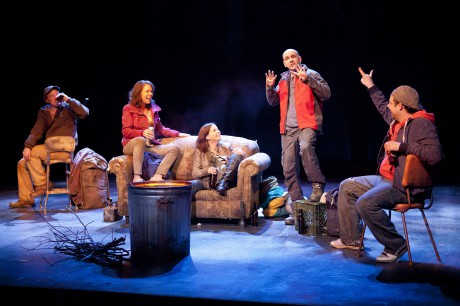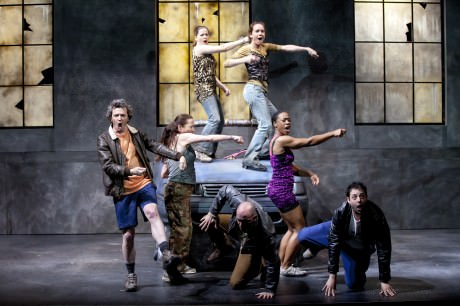Armageddon has arrived. The power has died. The grid is down. No more television, no more radio, no more internet. No electricity. And the best way to pass the time is to recollect old episodes of an animated TV comedy series in exacting detail to the best of your recollection. That is the world that is forged in Anne Washburn’s Mr. Burns, A Post-Electric Play, presented at Woolly Mammoth Theatre Company as the final play in its season about the demise of civilization.

A group of tenacious survivors clings desperately to the world that has vanished from their grasp; struggling to hold together what they can remember of The Simpsons in an attempt to recreate the world of electronics that have passed them by. What emerges over time is a desperate industry – a crude recreation performed in theatrics of the digital culture that cannot be lived without. The play delves through levels of coping, loss, with hints at the theory that success must form from the ashes as this group of characters tries to carry on. Washburn’s work leaves you questioning reality and how you would come to make sense of the world if all of the electronic gadgets and ways of life you knew simply stopped working.
The play is a thought-provoking reflection that is eerily reminiscent of the children’s game ‘telephone,’ only applied on a much grander scale to a post-apocalyptic world. One person hears something, sees something, recalls it – and to the best of their ability passes it on to the next person and then that person passes it on to the next. The end result is a trickledown effect of distortions and rearrangements of fact into opinion and conceived notions. Washburn’s work examines how in a time where only memory is reliable that even written word, documented as evidence, can come into question as to whether or not it is valid.
Director Steven Cosson takes this work to the stage with a level of detachment necessary for interpreting the true issues of the text. The characters, when faced with the desperation of reality, find themselves jovially engaged in conversation and reenactments of the popular television series The Simpsons. These moments on stage float lightly and with ease, a stark contrast to the gravity of the actual situation. In order for the characters to cling to hope and thus survive these moments of simplistic joy, dare I say ignorance, are executed with subtle finesse. Cosson lets each of the performers find their happy moment, be it remembering a particular line from a particular episode with extreme enthusiasm, or busting a move in the pop-cultural dance commercials in Act II.
One of the more entertaining aspects of the show is its flash-mob style choreographed dance scene in Act II. Choreographer Diane Coburn Bruning creates a series of modern dance moves on top of and around half of a car that is wheeled on stage. Bruning captures the essence of strained recollection in this choreography with fragments and pieces of dances used in the music videos of the time – as well as little dance gestures that were born in the aughts decade. Seeing the actors give their bodies over to the dance maneuvers in this montage of modern music from that period – is like channel surfing through VH1. It really gave the sense that they were frantic not to let what little they could remember slip from their minds.

The show progresses from the beginning of the meltdown to a period seven years later, and then 75 years later. As the show evolves, the characters become more and more bizarre, recalling less and less until finally it is no longer about recollection but about creation; or recreation of what they once knew and have now made into their reality. Following this progression is not difficult, but as the play moves on it spirals into a dark and bizarre world that leaves you questioning the progression of the real world.
The characters that adapt themselves to the various Simpson characters have some uncanny vocal and physical resemblances to these animated icons. When Gibson (Chris Genebach) appears on the scene as the stranger and suddenly bursts into the score of H.M.S. Pinafore, he sounds almost identical to Sideshow Bob with his vim and vigor and perfectly British intonation. Genebach also experiences post-traumatic stress disorder with violent vocal outbursts, which rip the reality of Simpsons recreation apart at the seams when memories seem to escape him more than most. It is both haunting and terrifying to watch his mind cycling through what isn’t there – as he makes the audience connect to any moment in their life where they were not completely cognizant of an event or memory.
Matt (Steve Rosen) taking on the role of Homer, however briefly, is beyond amusing. He sounds almost like yellow-skinned fat man as he nods and makes short responses; a comic copy that must be seen to be believed. His interactions with the other characters seem the most involved, he makes more eye contact than any of the other actors and this sets his performance apart as the one who has absorbed himself into his character’s desperate need to maintain a sense of normality.
The real challenge is the musical escapade in the third act. The actors become gross caricatures of The Simpson family, taking to the makeshift stage with a dark musical version of the Cape Fear episode where everything is upside-down to the point of Mr. Burns (played by James Sugg) being the villain. The music composed here, by Michael Friedman, is a mixture of haunting dramatic music and familiar tunes like “You’re A Mean One, Mr. Grinch” repurposed to Mr. Burns.
The cast surges through to the end, allowing the audience to see the gross reality that has become of society, creating an unsettling feeling for on-lookers. Erika Rose, as Bart, is the most captivating performer in this final push through to the end, singing out in a way that you would never expect Bart Simpson to do, and yet putting a finality on the alternate reality that has come of this creation. Rose’s character is not introduced until Act II but she makes up for lost time by making every moment she is on stage present and focused with a grounding in her core that radiates confidence to the audience.
Running Time: approximately 2 hours and 20 minutes with a brief pause between Acts I & II, and a 15-minute intermission between Acts II & III.
Mr. Burns, A Post-Electric Play plays through July 1, 2012 at Woolly Mammoth Theatre Company located at 641 D Street NW in Washington, DC. For tickets, call the box office at (202) 393-3939, or purchase them online.





